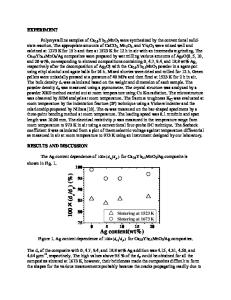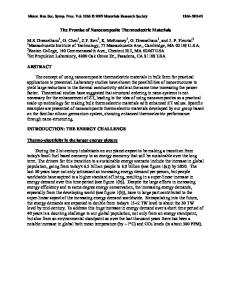Mechanical Characterization of PbTe-based Thermoelectric Materials
- PDF / 1,543,618 Bytes
- 6 Pages / 612 x 792 pts (letter) Page_size
- 82 Downloads / 372 Views
1044-U04-04
Mechanical Characterization of PbTe-based Thermoelectric Materials Fei Ren1, Bradley D Hall1, Jennifer E Ni1, Eldon D Case1, Joe Sootsman2, Mercouri G Kanatzidis2, Edgar Lara-Curzio3, Rosa M Trejo3, and Edward J Timm4 1 Chemical Engineering and Materials Science, Michigan State University, East Lansing, MI, 48824 2 Department of Chemistry, Northwestern University, Evanston, IL, 60208 3 High temperature materials laboratory, Oak Ridge National Laboratory, Oak Ridge, TN, 37831 4 Department of Mechanical Engineering, Michigan State University, East Lansing, MI, 48824 ABSTRACT PbTe-based thermoelectric (TE) materials exhibit promising thermoelectric properties and have potential applications in waste heat recovery from sources such as truck engines and shipboard engines. TE components designed for these applications will be subject to mechanical/thermal loading and vibration as a result from in-service conditions, including mechanical vibration, mechanical and/or thermal cycling, and thermal shock. In the current study, we present and discuss the mechanical properties of several PbTe-based compositions with different dopants and processing methods, including n-type and p-type specimens fabricated both by casting and by powder processing. Room temperature hardness and Young’s modulus are studied by Vickers indentation and nanoindentation while fracture strength is obtained by biaxial flexure testing. Temperature dependent Young’s modulus, shear modulus, and Poisson’s ratio are studied via resonant ultrasound spectroscopy (RUS). INTRODUCTION Thermoelectric (TE) materials are potentially important in harvesting waste heat energy from the exhaust of engines and from other heat sources. Despite the recent development of TE materials with ZT values greater than one [1], there is still very little information in the literature about the mechanical properties of TE materials. Thermoelectric materials are typically heavily doped semiconductors [1] and semiconductors are typical brittle materials, thus the mechanical properties that are of interest include the hardness, Young’s modulus, shear modulus, Poisson’s ratio, fracture strength, and fracture toughness. The hardness, H, is a useful material parameter since wear mechanisms are functions of hardness. Also, for well-processed and dense materials, the value of H/3 approximates the compressive fracture strength of the material [2]. While the fracture strength is critical to the design of TE devices, the elastic moduli, including Young’s modulus and Poisson’s ratio, are important materials properties needed for stress analysis of TE modules by finite element method [3]. EXPERIMENTAL PROCEDURE In this study, the ingot specimens (Tables 1 and 2) were cast from high purity elemental materials using a three-zone rocking furnace. The detail of the ingot casting was given elsewhere
[4]. The hot pressed specimens (Tables 1 and 2) were fabricated using ball-milled powders [5]. The maximum hot pressing temperature ranged from 300oC and 420oC while the pressure during sinte
Data Loading...











